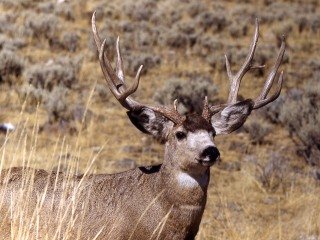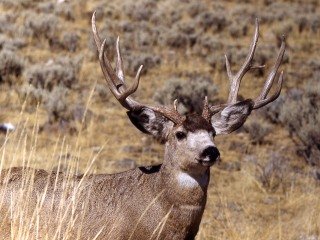 This is mule deer country. It’s big, open country where miles add up quickly. You need quality binoculars and spotting scopes with time spent behind them. Putting in long miles with steep climbing makes the difference between small or no bucks and the bruisers that haunt this dry country like ghosts. Like ghosts, the bruisers appear and disappear in scrub brush that doesn’t look like it could hide a jackrabbit. Throughout the desert west and southwest, giant mule deer have become perhaps the most sought after and misunderstood trophy.
This is mule deer country. It’s big, open country where miles add up quickly. You need quality binoculars and spotting scopes with time spent behind them. Putting in long miles with steep climbing makes the difference between small or no bucks and the bruisers that haunt this dry country like ghosts. Like ghosts, the bruisers appear and disappear in scrub brush that doesn’t look like it could hide a jackrabbit. Throughout the desert west and southwest, giant mule deer have become perhaps the most sought after and misunderstood trophy.
From well south of the Mexican border ranging north well into Canada, the mule deer offers hunters a classic western hunt, complete with opportunity and frustrations. Big mule deer tend to live in either wide open places where they can see for miles or broken rim rock country where two good jumps can put them around a corner and cement their image into a special spot in your hunting memory.
In rim rock country, use early morning hiking to put several miles between yourself and any roads. You want to be well on your way up the hill when the sun breaks. Preferably at daybreak, you crawl out to the edge of the rocks in some sheltered nook to watch a ravine or sage flat. Often times you can see for miles so use quality spotting scopes. When deer are spotted, they are often well out of range and careful planning is necessary to use the terrain and wind to get within fair shooting range.
Stalking mule deer requires using the terrain to the best advantage and keeping track of the wind, especially if the stalk will put you close to the deer at the moment of truth. Sometimes after a long stalk the deer have ghosted off, leaving the hunter to wonder if they made a mistake or if the deer just wandered on. If deer hunting is your passion and you haven’t climbed the rim rocks in the gloaming of a dawn and a dusk in the same day, make sure you plan to hunt them soon. The deer are huge and the country is breathtaking.








